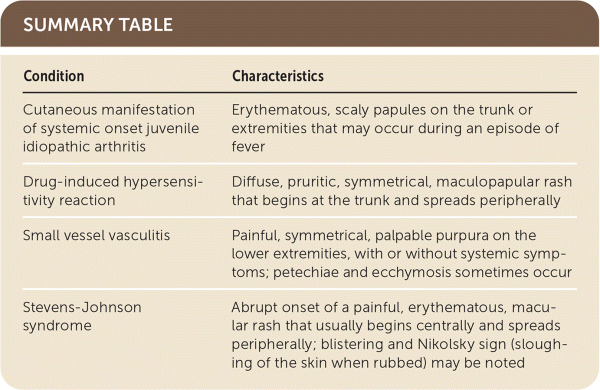
Rapidly Spreading Erythematous Rash
Am Fam Physician. 2022;106(2):193-194
Author disclosure: No relevant financial relationships.
A 40-year-old woman presented to the emergency department with a rash that began on her chest and spread to her extremities. She had a history of systemic onset juvenile idiopathic arthritis, chronic pain, and hypertension. Two weeks earlier, she was diagnosed with septic arthritis in her left knee that was treated with systemic ceftriaxone.
Physical examination showed a diffuse, pruritic, erythematous, maculopapular rash in a reticulated pattern (Figure 1). The patient responded well to high-dose oral steroids.

Question
Based on the patient's history and physical examination findings, which one of the following is the most likely diagnosis?
A. Cutaneous manifestation of systemic onset juvenile idiopathic arthritis.
B. Drug-induced hypersensitivity reaction.
C. Small vessel vasculitis.
D. Stevens-Johnson syndrome.
Discussion
The answer is B: drug-induced hypersensitivity reaction. This patient had a type IV hypersensitivity reaction, which appears four to 21 days after initiation of the causative medication. Although antibiotics are the most common inciting agents, nonsteroidal anti-inflammatory drugs, antiseizure medications, and chemotherapeutic agents have also been implicated. Risk factors include immunosuppression and viral infections in children.
An exanthematous or morbilliform eruption is the most common drug-induced hypersensitivity reaction. It is typically seen as a diffuse, pruritic, symmetrical, maculopapular rash that begins on the trunk and spreads peripherally. A morbilliform rash accounts for 80% of cutaneous drug reactions in adults and 35% in children. Additional clinical findings may include fever, malaise, lesions on the mucous membranes, ocular involvement, pustules, blisters, desquamation, purpura, skin tenderness, facial edema, sacral edema, pharyngitis, meningitis, or arthralgia. From 1995 to 2005, the estimated mean annual incidence of visits related to cutaneous adverse drug events was 2.26 per 1,000 cases in U.S. emergency departments or outpatient clinics.1,2
Systemic onset juvenile idiopathic arthritis (Still disease) is a rare inflammatory disorder with systemic symptoms such as fevers, rash, arthralgias, and joint pain. Erythematous, scaly papules, predominantly involving the trunk or extremities, may occur during an episode of fever. Major diagnostic criteria for the condition include fever greater than 102.2°F (39°C) for more than one week, arthralgia or arthritis, typical evanescent rash, and leukocytosis (greater than 10,000 per μL [10 × 109 per L]). Minor criteria include sore throat, lymphadenopathy, hepatomegaly or splenomegaly, and abnormal liver function test results.3
Small vessel vasculitis, also known as leukocytoclastic vasculitis and allergic vasculitis, is inflammation of the small vessels that can result in vessel destruction and extravasation of red blood cells. This can restrict blood flow and damage vital organs and tissues. The rash usually presents as painful, symmetrical, palpable purpura on the lower extremities, with or without symptoms of significant systemic vasculitis. Pruritus and aching pain usually occur due to tissue swelling. Petechiae and ecchymosis sometimes occur. Causes include infection, autoimmune conditions, drug hypersensitivity reaction, and lymphoproliferative disorder.4
Stevens-Johnson syndrome is a rare, serious condition. The erythematous, macular rash usually begins centrally and spreads peripherally, typically involves less than 10% of the skin surface area, and may become confluent and involve mucous membranes. Blistering and Nikolsky sign (sloughing of the skin when rubbed) may be noted. Clinical features may include pain and a prodrome of fever, conjunctivitis, dysuria, and bullae formation. The most common cause is medication use, including sulfonamides, quinolones, penicillin, aspirin, acetaminophen, carbamazepine (Tegretol), nonsteroidal anti-inflammatory drugs, phenytoin (Dilantin), and corticosteroids. The syndrome can also follow immunizations. Lesions generally begin seven to 21 days after first exposure and within two days after a second exposure.5

| Condition | Characteristics |
|---|---|
| Cutaneous manifestation of systemic onset juvenile idiopathic arthritis | Erythematous, scaly papules on the trunk or extremities that may occur during an episode of fever |
| Drug-induced hypersensitivity reaction | Diffuse, pruritic, symmetrical, maculopapular rash that begins at the trunk and spreads peripherally |
| Small vessel vasculitis | Painful, symmetrical, palpable purpura on the lower extremities, with or without systemic symptoms; petechiae and ecchymosis sometimes occur |
| Stevens-Johnson syndrome | Abrupt onset of a painful, erythematous, macular rash that usually begins centrally and spreads peripherally; blistering and Nikolsky sign (sloughing of the skin when rubbed) may be noted |

